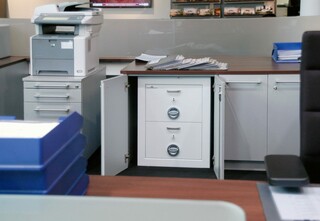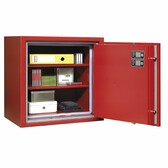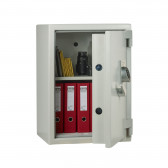A safe is not the same as a vault. We can call a safe both a small fireproof case for money and a high-class bank safe of the vault type being a separate room. So what are burglar-proof safes?
Anti-burglary safes – characteristics
This wide, popular group of safes is designed in such a way as to maximally protect their contents against forcing through by an unauthorised person. In other words, the safe is designed to prevent it from being ransacked. When buying such a device, it is worth remembering that not every model is anti-burglary; some are designed primarily to protect the contents against fire. Therefore, if we care about protection against theft, we need to choose a safe which has such protection (i.e. the appropriate class).
Classes of burglary safes
The choice of anti-burglary safes is enormous. They differ from each other not only in dimensions, equipment or appearance, but above all in resistance class, on which their strength depends. It is expressed in Roman numerals from I to XIII (with classes above VIII reserved for vaults). This strength also influences the amount for which the contents of such a device can be insured. Each time you buy a burglar-proof safe, you should therefore consider what and of what value will be stored in it. It is also worth considering the exposure of the stored items to fire – not every burglar-proof safe is fireproof at the same time – most protect the contents against this element only to a basic degree. It is only with an appropriate certificate that a safe can be described as fireproof. Among fireproof safes we can also distinguish classes.
Burglary resistance of a safe – RU units
Each burglary resistance class of a safe has an RU factor, which is regulated by the PN-EN 1143-1 standard. The values of a safe are specified by the decree of the Ministry of Internal Affairs and Administration of 7 September 2010, Journal of Laws No. 166. RU is a unit (Resistance Unit), which informs how resistant a safe is to attempts to get into it with the use of various tools. In order to determine the RU value, the safe is subjected to different methods of burglary and the time it would take a thief to access the contents with a particular tool is measured. This measurement does not take into account how much noise the burglar would make or whether there would be smoke during the attempted burglary (in other words, it is irrelevant whether the burglar would alarm the entire neighbourhood with his intrusion). The RU is expressed in two values (partial and total access). For example, RU 30/50 (safe class I) means that a thief would need 30 minutes for partial access and 50 minutes for total access to the safe's contents.

What are burglar safes used for?
Originally they were mainly used to store jewellery and money. Today we keep most of our money in the bank and important documents (e.g. insurance documents), works of art, valuable collections (e.g. coins) and information media are being stored in burglar-proof safes. The main rule is to keep in a safe whatever is valuable to us and could also be valuable to a thief (sentimental souvenirs – e.g. photographs – are better stored in fire-resistant safes, about which we will write soon).
Read another articles: How to prevent theft in your company? Part 1.





